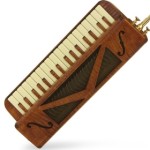Leakage
Tagged: leakage
- This topic has 20 replies, 8 voices, and was last updated 6 years, 4 months ago by
 Alan Brinton.
Alan Brinton.
-
AuthorPosts
-
November 4, 2014 at 11:37 pm #3364
 Alan BrintonParticipant
Alan BrintonParticipantA leaky melodica is like a leaky boat. Well, not exactly. But I noticed today, while working on two Piano 36 Hohners that both have mild leakage, that after playing one of them, as I was blowing into it forcefully with the spit valve closed, beading of water appeared at the two back corners of the bottom plate (by the back side of the melodica, I mean the side with “Hohner”). It then occurred to me to do what I’ve done to find leaks in inflatable boats and inner tubes, which is to submerge the melodica in water. When I blew into it (with the spit valve closed), bubbles appeared in just those two corners. (I know there is also some leakage with the long mouthpiece, which fits loosely, though not with the trumpet mouthpiece.) So air is escaping at those two corners. There’s no visible damage to the gasket. I’m pleased to have isolated the leaking, but I’m wondering what to do about it, other than tightening the screws, which I have already done.
November 4, 2014 at 11:46 pm #3365 DarenKeymaster
DarenKeymasterHow old is the gasket? Could it have lost some compression and need replacing?
November 5, 2014 at 1:05 am #3368 Alan BrintonParticipant
Alan BrintonParticipantI’m sure the gaskets are original, as this melodica has, I can tell from the reeds, been played very little. I don’t know the years of production for the Piano 36, 1970s?
November 5, 2014 at 9:00 am #3369 Adam TombsParticipant
Adam TombsParticipantJust a suggestion, you could try treating the gasket with some form of rubber conditioner. I use silicone spray lube on window seals in cars and it does soften the rubber and allow for putting a little bounce back in to it. The other thing you could do is use beeswax to stop your leaks. Piano Accordion repairers have been using it for a long time to good effect…
Another way to find leaks is to use a little dish washing detergent diluted in water on the supected area. Saves dunking the entire object in water and you get nice big bubbles to indicate where the leaks are, it’s an old outback trick used to fix punctured tubeless tyres while the tyres are still on the vehicle….
My piano 36 has a little bit of a leak where the water ‘valve’ is located cracks etc but I never worried about it as it requires very little breath to play at good volume.
November 5, 2014 at 10:43 am #3372 Alan BrintonParticipant
Alan BrintonParticipantThanks, Adam. I think it was Melodica-Me who said in an earlier thread that silicone might damage the gasket. I had been using it on my Suzuki Bass-24, which leaks like a sieve. Beeswax sounds like a promising possibility, especially if it’s something used by accordion users. I’ll try this:
I Googled “gasket in a can” to see what came up, which is this kind of product:
for auto-motive applications, but it is silicone based.
November 5, 2014 at 11:30 am #3373 QuetscherParticipant
QuetscherParticipantHi Alan,
honestly I wouldn’t use beeswax. Accordion manufacturers use it to fix single reed plates to the reed block to be able to remove them without a trace, but it hardens and you will need something flexible to prevent leakage. Instead you could buy straps that accordeon repairers use to tighten the bellows which are available in many sizes and diameters.
This is a german site but you can fand those straps everyplace.
November 5, 2014 at 4:14 pm #3374 QuetscherParticipant
QuetscherParticipantHi Alan (and sorry Adam!),
honestly I wouldn’t use beeswax. Accordion manufacturers use it to fix single reed plates to the reed block to be able to remove them without a trace, but it hardens and you will need something flexible to prevent leakage. Instead you could buy straps that accordeon repairers use to tighten the bellows which are available in many sizes and diameters.
This is a german site but you can fand those straps everyplace.
November 5, 2014 at 6:22 pm #3375 Alan BrintonParticipant
Alan BrintonParticipantThanks for chiming in, Quetscher. Do you mean bellows tape? I don’t see how bellows straps (as I see them on the site and in a Google image search) would be used with a melodica.
I was thinking during the night (why waste time sleeping) that if beeswax were applied to the gasket, that would preclude alternative solutions to the problem by the way in which it would compromise the gasket.
November 5, 2014 at 7:19 pm #3379 QuetscherParticipant
QuetscherParticipantOnce again pardon my English. I mean neither bellows straps nor bellows tape, I mean an original accordion gasket that is used to prevent leakage between the bellow and the body, but as I write this I have to state that this seems to be what Troy already suggested; so sorry for the redundant comment…
Nevertheless I’m sure beeswax wouldn’t work, and if you applie it to the gasket, wouldn’t it make the gasket too inflexible?
I guess I’d rather try out gaskets with different diameters – I own a Hohner Professional with exactly the same leakage problem and will experiment a little just like you…November 5, 2014 at 8:13 pm #3382 Alan BrintonParticipant
Alan BrintonParticipantThanks for the clarification, Quetscher. I’m not sure if the leakage is enough of a problem to justify creating a new gasket, and it’s probably not possible to order a replacement. I’ll need to think more about this!
November 9, 2014 at 7:24 pm #3409 Alan BrintonParticipant
Alan BrintonParticipantHa! Experimental Setback. I tried to improve the seal on #1 Piano-36 with Ultra Black Gasket Maker (in a tube). Although I followed curing instructions, it stuck the back on so the melodica could not be reopened without destroying the gasket.
A new gasket could be created with Ultra Black, and I may try that, but I’m pessimistic about results. Has anyone tried silicone gasket tape such as this product?
November 10, 2014 at 12:59 am #3410 DarenKeymaster
DarenKeymasterAlan, you could try accordion bellows gasket, available in different widths etc
November 10, 2014 at 2:05 am #3411 Alan BrintonParticipant
Alan BrintonParticipantGood idea, Daren aka. I’ll look into that. Thanks.
December 29, 2015 at 7:10 pm #6632 Bruce KriegParticipant
Bruce KriegParticipantI just purchased a 1960’s Piano 36 and it is in incredible condition. No leaks. However, I heard something that sounds like a small plastic piece bouncing around when I tip the melodica from side to side. Today I was going to remove the back plate and investigate where the ‘broken plastic piece’ was. I couldn’t get the back plate off AND when I screwed the screws back in place there are air leaks when I blow through. The worse part is the spit comes through the leaks. I’m so discouraged. I shouldn’t have taken it off. Anyone know what I can do? I appreciate your time. Bruce
December 29, 2015 at 8:06 pm #6633 Alan BrintonParticipant
Alan BrintonParticipantThe first thing I would do is to loosen all those screws up and then work your way around the whole pattern of screws, slowly and gradually tightening each one until they are all fairly tight. Not too tight, but when they are all reset fairly well, see whether air is still escaping. If so, repeat the process tightening just a bit more. But don’t force the screws too hard, as the holes can strip and (if it’s a really old specimen) a screw can break in the middle.
If you completely screw down one screw at a time, you’ll get a less even seal.
It’s not unusual for the metal back of a Piano 36 to be hard to get off, Bruce. Doing so might compromise the gasket seal, but I don’t know how else you can figure out what the problem is. To take the back off, don’t start by trying to pry under its tight seal with a screw driver. Hold the melodica down flat, firmly with one hand, and jerk up on the handle, leveraging on one end and alternately on the other. Once the seal starts to release, you can carefully work your way around the cover prying gently with a tiny screwdriver. If you then take some photographs and post them here, those of us who have disassembled this model may be able to provide helpful advice.
Before you try to disassemble, though, wait to see what others here who have worked on the Piano 36 have to say. I personally would want to see what’s bouncing around inside (a screw?) and take a look at that soft note you mentioned to me, which might be a gapping issue.
This kind of thing can be very discouraging, but it’s par for the course for anyone who collects vintage melodicas. If you’re temporarily stuck, I can send you a loaner for the cost of postage or get it transported some other way. I’m in Boise.
-
AuthorPosts
- You must be logged in to reply to this topic.
